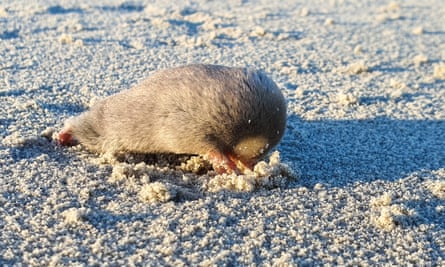A rare and shimmering golden mole, whose last sighting was prior to World War II, has been found once again “swimming” in the sand near the seaside town of Port Nolloth in the north-west region of South Africa.
The De Winton’s golden mole, also known as Cryptochloris wintoni, was thought to be extinct but has recently been discovered living in underground burrows. It has not been sighted since 1937. Its fur is coated in oily secretions, giving it a “golden” appearance and allowing it to glide through sand dunes instead of digging traditional tunnels, making it difficult to spot.
This creature is blind and heavily depends on its acute sense of hearing. It will quickly run away if it detects any vibrations from movement on the surface. It has been included in Re:wild’s list of endangered species, making it one of the most sought-after species to protect.
After 86 years since its last appearance, the mole has been found again with the help of conservationists and a border collie named Jessie, who was taught to detect golden moles. The results of their search have been reported in the publication Biodiversity and Conservation.
Esther Matthew, a senior field officer at the Endangered Wildlife Trust (EWT), expressed her excitement about being a member of a team that searches for lost species. She added that the ultimate highlight was discovering one.

Scientists from EWT and the University of Pretoria collaborated with Jessie, a dog who signaled the discovery of a scent by lying down on the spot. In return for her contribution, Jessie was given the opportunity to play with her tennis ball as a reward.
Every time she paused, they gathered a sample of soil, which was subsequently analyzed for environmental DNA (eDNA). This method is capable of detecting DNA from skin cells, urine, feces, and mucus, which the moles emit as they travel through the dunes. With this approach, the team combed through up to 18km (11.2 miles) of dunes per day. In total, they obtained 100 samples of sand and ultimately came across two De Winton golden moles.

Research was conducted in 2021, and the group suspected they had identified the mole, but De Winton’s closely resembles other golden moles, therefore the discovery was not verified until samples were genetically analyzed.
Cobus Theron, a senior conservation manager at EWT and part of the search team, expressed his confidence in the existence of De Winton’s golden mole, despite doubts from others. He also highlighted the potential of utilizing eDNA technology to aid in the discovery and preservation of other endangered species.
There are a total of 21 recognized types of golden moles, with the majority found exclusively in South Africa. The researchers discovered indications of three additional mole species, including the Van Zyl’s golden mole, which is also classified as endangered.
In 2021, EWT conducted research and discovered four additional groups of De Winton’s golden moles. Experts suggest that a thriving population of these moles can be found in Port Nolloth. Unfortunately, the area is at risk due to diamond-mining and lacks protection.
“We must pinpoint specific regions to prioritize our conservation endeavors… and establish safeguarded territories to ensure the persistence of these species,” stated JP Le Roux, a previous EWT field agent.
Find more age of extinction coverage here, and follow biodiversity reporters Phoebe Weston and Patrick Greenfield on X (formerly known as Twitter) for all the latest news and features
Source: theguardian.com
















